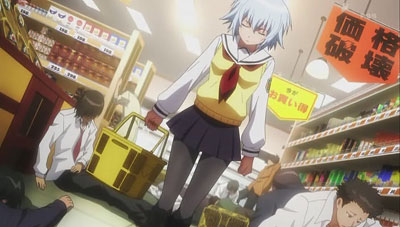
Last Exile – Ginkyo no Fam has done nothing to dispel the reservations I expressed previously. Looking around the Web, I see that it has attracted a fair amount of comment. Much of this is uncritically favourable, or goes into great detail about the personalities of the various characters. There are a few negative reviews that raise some awkward and pertinent questions, such as:
Why are we constantly told that Fam is a great pilot, and not shown so that we can judge for ourselves?
Why is more not made of the potential of the small “vanships” to usher in new kinds of weapons and new ideas about how to conduct military operations?
Why introduce “fan-service” and idiot behaviour by the principal characters at the opening of the 2nd series?
Why are sections of the plot so jaw-droppingly implausible? Such as the sequence where the older princess is snatched off the deck of her flagship. (What a stupid place to stand! What an unlikely manoevure!). Her friends figure out exactly where she is, fly through a battle zone, infiltrate the Ades flagship through a gap in the hull (somebody really ought to tell the Turan general staff about that hole in the armour belt), fly around inside the vast hull encountering only light opposition, finally to confront the enemy commander.
Why set up the Ades Federation as the bad guys plotting genocide and killing the princesses’ father, and then confuse this simple but fit-for-purpose plot by having a scene that depicts Turan as land-grabbing invaders?
When is the show going to bother explaining what is going on and fill in minor but interesting details like what exactly happened to the Turan flagship and its crew?
One would like to think that there’s a clear resolution of how the nice princess suddenly has super-powers that allow her to vape a city with an interplanetary spaceship that pops up like a rabbit out of a hat, but in view of the above, I doubt it very much.
And why are the pirates, who should be a pragmatic and self-interested bunch, aligning themselves with Turan, which has just lost the war, and against Ades, the most powerful military machine on the planet? (Clue: most of them fled from territories over-run by Ades).
Clearly one is supposed to ignore these awkward questions and instead enjoy a predominantly young and female set of characters expressing their feelings and generally acting up like uncontrolled adolescents for much of the screen time.
Category: anime
Anime reviews sub-category
Fall 2011 anime – second week
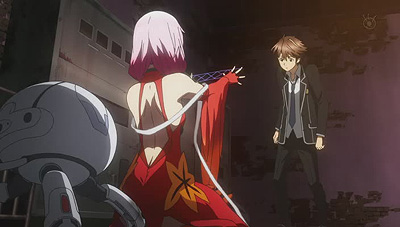
Chihayafuru #2: The second episode is entirely a flashback to elementary school, where Taichi and Aruta have a karuta battle. Maintains the high standard of episode #1.
Tamayura – Hitotose: #2: The second episode was pleasant, but doesn’t greatly change my opinion about this show.
Phi Brain: Kami no Puzzle: #2: The second episode introduces an annoying character, and the second puzzle, with car-shunting, was rather silly. Goes down in my estimation.
C3 #2: There is more action in episode 2, when a powerful and malign character appears, but I didn’t feel involved and it felt formulaic. Will probably drop this.
Kimi to Boku (You and Me) #2: One of the boys tries to help a fierce little girl who resents his efforts. A bit blander to watch than it reads.
Maken-Ki #2: More of the same lingerie catalogue. See comments on episode #1.
Mashiro-Iro Symphony #2: The boys try to ingratiate themselves, with mixed results. There was little to tempt me to watch any more.
Last Exile – Ginkyo no Fam – Preview: It looks like the flying mecha will be great, but with mention of pirates and princesses, I don’t have much confidence about the plot. The show has been heavily promoted at overseas anime conventions, and is licensed to Funimation already.
Ben-Tou #1: The hero lives in a dorm, and so has to provide his own lunch and dinner. The half-price bento in the supermarket look tempting, but whenever he tries to buy any he is knocked unconscious and trampled underfoot by hungry and violent students. A friendly girl accosts him, but he can’t remember who she is. The most violent of the bento-buying girls offers to let him join her club. It’s quite amusing so far.
Mobile Suit Gundam AGE #1: It’s another Gundam series, and so far quite similar to the earliest series. The young hero, Flit, is handed a memory chip by his mother, who is dying in a collapsed and burning building. It contains plans for a giant robot suit. Years later, Flit, now a teenager, is helping develop that mobile suit, now called the Gundam. He has a cute girlfriend, and a bouncing ball robot pet. Unknown raiders, called the UE for short, attack the space colony in a graphically animated attack, causing considerable destruction, and Flit starts up the untested Gundam and defeats one of the UE machines. Flit looks about ten years old, and one has the impression that this series is aimed at a young age-group. BTW, when I was a boy, “Flit” was a popular brand of insecticide, but that’s not the only reason I am unable to take this show very seriously.
Mirai Nikki (Future Diary) #1:
In the opening scenes, we see the hero wandering around school, obsessively texting a diary of trivia into his mobile phone, and evading the attention of bullies who dislike him partly because he doesn’t mix with his classmates. He has a rich fantasy life in which he talks to an all-powerful God in his bedroom. Unfortunately, a serial killer starts knifing people near the school, and then the God turns out to be real, and hands our hero a smartphone that predicts the future.
I agree that the hero clearly needs psychiatric help, but one can empathise with his fear of the bullies. The bully mentality (needing somebody they can feel superior to, and getting annoyed when the victim doesn’t follow the script) is depicted quite accurately here. This develops into one of the most riveting anime episodes I’ve seen for ages. For this guy, having that girl take an interest in him would be enough to scare him witless, but she keeps appearing in front of him as he tries to run away. What does she want? Is she connected to the serial killer? He dosn’t want to die horribly just yet. We suspect that in fact she just wants to talk to him, but it’s still thrilling. Actually she has a future diary too, and she wants to save him. It turns out that the future diaries predict deaths, and in the God’s deadly game, the last player to foil the predictions and survive, will gain supreme power.
Sure, it’s about as plausible as a political party manifesto, and seems set to cross off one killer every week, but it looks like an exciting entertainment.
Un-Go #1: This is a detective comedy thriller, set in a near-future Japan which has passed through some sort of crisis. A politician about to be arrested on corruption charges holds a party. Unfortunately he is murdered during the party. There are two rival teams of detectives, reclusive Kaishou with his computers and cameras and his daughter Rie, and the “Defeated Detective” and his odd assistant Inga. Rie attends the party, but her team is out-thought by the “Defeated Detective” and the unlikely killer unmasked. That’s a lot to fit into 25 mins without rushing, and this show could have used more time to set out its stall. However it’s a stylish-looking show and has promise.
Guilty Crown #1: In a near-future Japan which has had a plague crisis and is now occupied by a foreign force, the GHQ, Shu Ouma, a nerdy boy, explores a deserted site and comes across a wounded girl. She has a secret something which she insists he delivers for her. He recognises her as a well-known idol singer, and she urges him to take a cat’s cradle from her. He hesitates, mesmerised by her partial state of undress. GHQ thugs arrive and drag the girl away, while Shu cowers on a platform above. He does, however, deliver the object, and a band of insurgents led by a long-haired bishie collect it. Minutes later, the GHQ launch a general attack, ostensibly to cleanse the area of infection. While citizens are shot down in the streets and the insurgents counter-attack with a kind of mini tank, Shu somehow finds the escaping girl and tries to get her to safety. At this point it all goes a bit supernatural, with him taking the girl’s essence and going off to smite the GHQ mecha with a long swordlike thing. Phew. It’s all vividly animated and the action hardly ever stops. Wish-fulfilment rules OK. It looks good, which may be enough to persuade one to overlook a certain lack of plausibility. And did I mention before how the Fall anime come in pairs?
Fall 2011 anime -first looks

It’s time to have a look at the latest TV anime from Japan, starting with the best, and working downwards. Most titles are licensed for streaming.
Chihaya furu:
The heroine, Chihaya, is a beautiful, confident and strong-willed girl who is fascinated by the card-game karuta. In this, a poem is read out, and the players have to grab the card with the second verse on it. On starting at a new school she tries to start a karuta club, but with seemingly little success. She also re-encounters a boy, Taichi, who was in her class at elementary school and is rather disappointed to find that his interest in the game has waned. In an extended flash-back we learn how Chihaya became interested in karuta. A poor and unpopular boy, Arata, reveals his passion for karuta and fires Chihaya’s interest in it. The younger Taichi bullies Arata, angering Chihaya.
We are told that Chihaya, despite being a bijin is not popular with boys, but the first episode fails to show me why. Seemingly the immature and idealizing minds of teenage boys are to blame. Does Chihara like being sociable? This is left unclear. Chihaya’s sister is a model, but Arata tells Chihaya that she should have a dream for herself.
I’d never heard of karuta, so I Googled it a few days ago. Seems there are many karuta variants, and the poem-based 100-card game in the anime is one possible variant.
In the first week of the season, only with Chihaya furu did I experience the excitement of seeing a show I might actually want to watch.
Altogether, interesting, and no supernatural or ultra-violent content.
Streamed by Crunchyroll, inc. UK

Hasegawa Kodaka is a half-English transfer student who has recently enrolled in a Japanese high school run by a religious order. Because he looks foreign and has difficulty in acting normal, his classmates think that he is a delinquent and want nothing to do with him. One day after school Kodaka finds a classmate named Mikazuki Yozora talking aloud to an imaginary friend in an empty classroom. Yozora is a sarcastic, aloof girl,has poor social skills, and turns people off easily. The two talk warily, and find common ground in that neither of them knows how to make friends, yet they both want to have friends so that they will be perceived as being more normal.
Yozora goes off and starts a “Neighbors†club, enrolling Kodaka without his knowledge, so that they can learn how to make friends without going through the social discomfort and problems of joining an existing club mid-term. But just as they get started with the club they are surprised as another student wants to join – a girl named Kashiwazaki Sena who is smart, beautiful, athletic, and popular with boys. It turns out that Sena wants to have a normal friendship with other girls, but instead scares off other girls because they feel that they can’t compete with her. But this is a club filled with strife as Kodaka doesn’t really care to be in it, and Yozora and Sena can’t stand each other and fight incessantly. [Thanks to Dave Baranyi for help with the synopsis :-)]
This immediately caught my attention because it is well-scripted and deals with a real teenage problem. Some people (and not just teenagers) just don’t have the knack of making friends easily, and teenagers are quick to reject anyone who seems a bit gloomy or different. It’s also quite funny, and it’s quite believable that two of the friend-seekers actually can’t stand each other. It’s less believable that Yozora (when she’s lively) is much prettier and more personable than some social outsiders I’ve come across (in fact she’s near enough as pretty as princess Sena.) One has to go to the anime “Princess Jellyfish” for a more forthright depiction of social failure girls. Sena is blonde, but this seems to be just anime hair-colour artistic licence, not an indication that she too is foreign.
An interesting show, and I’m eager to see how it develops.
(By the way, don’t bother watching the “episode 00” preview. It tells one nothing about the flavour of the TV show, beyond suggesting that there will be more female characters, which is scarcely an enormous surprise. A complete waste of time.)
Tamayura – Hitotose: A TV series based on a slice-of-life OAV series from last year. A girl whose father recently died takes up her camera again, and her mother decides to move them back to to her father’s hometown. A well-produced and well-meaning show, but the first episode could have done with a bit more substance and less tearful emoting from a minor character. A series about looking and photographing can work well as an anime, but one will have to see whether this one maintains one’s interest or not.
Phi Brain: Kami no Puzzle: The hero, Kaito, is a smart student at a private high school, but looks like a delinquent. In the opening scenes, he rescues an adult gamer who has become trapped in a life-threatening puzzle maze. He scorns the approaches of the school’s gaming club, but succumbs to the lure of a mysterious and dangerous challenge. Soon he is off attempting to solve a maze. This isn’t the world as we know it, but a magical world in which huge puzzles are constructed near schools.
On his quest, he is trailed by the violent Childhood Friend, Nanaho, who for once isn’t just there to bring him lunches and beat him up when he gets out of order, but provides vital puzzle-solving assistance.
We’ve seen these elements before, but this isn’t badly done, and it will clearly progress through the quest week by week, so may be worth checking further.
Persona 4 the Animation: Apparently this is a game adaptation. A fairly ordinary school student finds strange things happening around him. At midnight a TV set tries to suck him in, then in a TV showroom he and friend fall through a giant set into a very strange world where they are confronted by a puppet thing and then chased by menacing giant tongues, which the hero defeats by somehow summoning a Persona. It was hard to suspend one’s disbelief in the face of this rapid succession of implausibilities. I think you need to be familiar with the game to dig this, so I’m dropping it.
Fate/Zero: A prequel to Fate/Stay Night, which I never saw. The first episode has more talk than action, and I’m not a fan of this sort of elaborate supernatural combat drama, so will drop.
Streamed on Crunchyroll, inc. UK
C3: The hero receives a mysterious cubic box by post from his adventurer father. The box soon turns itself into a naked magical girl who proceeds to turn the boy’s life upside down. Fiya claims that she has been “cursed” and is looking for a cure. None of this is particularly original or well-done, but I thought the scene where Fiya insults the Childhood Friend was hilarious. In the ending preview there are hints of some heavy-duty baddies to be introduced. Whether the Childhood Friend has any special ability remains to be seen.
Not great but it had some tasteful nudity and a bit of panty-flashing, and some humour.
Kimi to Boku (You and Me): Slice of life school story, but this time with the startling novelty of a group of boys instead of girls. They spend the first episode trying to persuade one of their number to join a club. Not exciting, and the characters are not particularly interesting.
Streamed on Crunchyroll, inc. UK
This season the less appealing anime come in pairs:
Maken-Ki: An insignificant youth enters a high school which has just gone co-ed. He has just graduated from an all-boy school and thinks his luck is in. Even more so when he meets his former dojo sparring partner and finds that she is now his sempai and has grown into a beautiful, buxom, and micro-skirted girl. Like everyone else, she fails to point out that this is a school where the students fight each other in magical battles. To school, where our hero soon fall foul of a combative girl who clearly hates him. Forced to fight at the school entrance ceremony, our hero is rescued by a purring sexpot he has never seen before, who claims to be his fiancee. We can skip over the rest, except to point out that there are so many bouncing boobs, crotch shots, tight white panties and firm thighs in this that the startled viewer may briefly wonder if he’s having a sex fantasy himself.
and
Mashiro-Iro Symphony: In the first part of episode 1, the hero spends some time trying to locate his cute but apparently mentally defective sister, who has got herself lost on the way to the shops. This touching study of disability ends when she is rescued by another cutie, also lost, but in possession of a working cellphone. In the second half we learn that our hero is joining a girls’ school which is in the process of merging with another school and going co-ed. At the assembly, the new boys are confronted by the cutie, who announces that she is the headmistress’ daughter, is totally opposed to the merger, and will not welcome boys. This is an adaption of an ero-game, but the character designs for the girls are in a generic moe/shoujo style. I nearly forgot to mention the bouncing globe creature that looks alarmingly like the sinister Kyube from “Mahou Shoujo Madoka Magica”, and the generic guy friend.
Maji de Watashi ni Koi Shinasai: Two school classes battle it out. An appalling show full of senseless violence, super-powered nonsense and tired cliches. To summarise it and explain its many annoying defects would be to give it more column inches than it deserves. Avoid.
and
Kyoukai Senjou no Horizon (Horizon on the Middle of Nowhere): The human race has gone back into the past, we’re told, to re-create its history. Cue a school training camp and a lot of senseless violence, super-powered nonsense and crude racial stereotyping. There isn’t even any plot to summarise, as far as I can see. Avoid.
Several sequels:
Hunter x Hunter, Shinryaku!? Ika Musume, Bakuman 2nd Series, Working. I had enough of these first time around so I don’t need to check them again.
Hunter x Hunter is streamed on Crunchyroll.
Summer 2011 anime – first looks
The Summer Anime season is starting, so here’s my impressions of the first items to be shown:
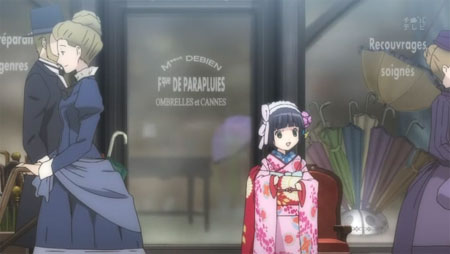 Ikoku Meiru no Croisee: In 1890’s Paris, a French trader brings back from Japan a small Japanese girl, with the notion that she can work as a maid at his grandson’s decorative ironwork shop, and attract customers. The grandson, initially, isn’t at all keen, and there are some cultural misunderstandings between the child, (fully dressed in traditional Japanese costume) and the French.
Ikoku Meiru no Croisee: In 1890’s Paris, a French trader brings back from Japan a small Japanese girl, with the notion that she can work as a maid at his grandson’s decorative ironwork shop, and attract customers. The grandson, initially, isn’t at all keen, and there are some cultural misunderstandings between the child, (fully dressed in traditional Japanese costume) and the French.
The plot of the first episode hinges on the characters speaking two different languages and being largely unable to understand each other, and for me the effect was ruined by having the whole thing dubbed in Japanese. [I should declare an interest in that I understand French and a little Japanese.] Perhaps things will improve in following episodes when the characters are all speaking the same language.
Sacred Seven: In this one, a loner schoolboy sees a supernatural monster destroy a passenger ship. There’s also a nice girl in his class who takes an interest in him. So far, we’re on familiar ground. However, when the anti-monster squad turn up, and turn out to be headed by a teenage girl addressed as “Milady” and driven around in a limousine, and their footsoldiers are gun-toting young women in sexy maid outfits, one starts to think that this anime may not be taking itself too seriously… Anyway, Milady tries to recruit our hero, much to his annoyance, and is rebuffed. The monster goes on the rampage again, and our hero does his transforming thing, and wins this round of the battle. Sacred 7 isn’t great, but looks like it could be good fun.
Rou Kyuu Bu! A high school boy is pressured by his older sister, a teacher, to coach an elementary school girls’ basketball team. Sis’s motives are partly to alleviate the lad’s basketball deprivation, his own team having being disbanded because of a scandal involving an under-age girl. Determined to create a good impression the five girls greet their coach dressed in maid outfits. Not much coaching gets done.
if you like a loli-fest, with semi-nudity, panties, and sex jokes, this could be for you. Personally, I prefer to keep this sort of thing at arm’s length. Nothing suggests that Rou Kyuu Bu will rise above this undistinguished start.
Double-J: An anime short with a running time of about 4 minutes. It seems to be a school slice-of life comedy. In the first episode, two girls visit a school club dedicated to the preservation of traditional arts. However the members seem to be doing pointless stuff like carving on the ends of toothpicks. It was quite amusing, and since it’s so short, seems worth the effort of following for a while.
Blade: Another anime with an American Marvel Comics link. The eponymous hero is a tough dude who despatches vampires with his silver-edged sword. This looks like the most satisfactory of the Marvel Comics co-productions, with plenty of action, and a vampire deletion-count running into double figures in the first episode.
Kami-sama no memo-chou (God’s Notepad):The characters include an ineffectual high school student, Narumi, and a teenage shut-in (hikkomori), known as Alice, and Alice’s gang of slackers, who with her form a detective agency. Alice, who spends all her time dressed in her pyjamas, in her apartment full of video screens, is definitely a loli. Narumi witnesses a violent incident, and thus meets Alice’s gang, who are investigating a mystery involving paid-for dating. The series has a relatively adult feel to it, and there’s some “fan-service”. Possible influences come to mind, perhaps too quickly (Victorique in “Gosick”, and “Durarara” to name two) and there’s the ubiquitous nice high-school girl taking an interest in our hero. Despite that, this is a well-made and gripping opener that holds the viewer’s attention over the opening double-episode, and is the best item in the new season I’ve seen so far.
Yuri Yuri: Three schoolgirls attend their first day at middle school, and soon form the Amusement Club. The red-haired girl in particular is a klutz, who wakes late and forget’s it’s her first day at school. Gag-based comedy with yuri elements. Don’t expect much of this juvenile stuff. Sasameki Koto it’s not.
Kamisama Dolls (God Dolls): College student Kyohei has escaped his oppressive village to study in Tokyo. Unfortunately it follows him there in the form of his younger sister Utao and the kukuri or god-doll. Their conversation is interrupted by his insane elder brother who has escaped from a cell in the village, with his kukuri, and has been leaving a trail of slaughter. On the plus side, a nice girl from the village lives nearby, and she and her father offer Kyohei and Utao somewhere to stay after Kyohei’s apartment is wrecked.
This is a straight supernatural drama, but I wasn’t altogether convinced, and there is a nagging feeling that I’ve seen something like the kukuri before.
Morita-san wa Muguchi (Taciturn Morita): TV anime with episodes a few minutes long, about a girl who thinks so much about what she has to say that she never says anything. Mildly amusing, and an idea I can relate to, and since it’s so short, it mightn’t hurt to watch some more episodes to see if it’s any good.
Blood-C: An original vampire story, from Production IG and CLAMP. It retains the name of the heroine from the original “Blood”, but here she is a cute-ified schoolgirl, tall and elongated in a distinct CLAMP style, and so clumsy she can’t run in a shrine costume without falling over, and so goody-goody she can’t pass a piece of litter without clearing it up. Despite that, she manages to deal with an attack by a malevolent stone statue efficiently enough, though getting blood-spattered and nearly killed in the process. Her dad walks down to check on the result, and Saya’s dialog can be paraphrased as “Hey dad, I killed the old one. No I’m not hurt a bit!” I wasn’t impressed, and I don’t think I’ll be following this one.
Poka Poka Mori no Rascal (Rascal of Snag Forest): Another short animation. Rascal Raccoon was a World Masterpiece Theater anime some decades ago. It’s not entirely clear whether this is an updated remake or a parody. Anyway, this anthromorphic character wakes up, and we have a raccoon version of the anime staple: gets up late, dresses in hurry, bolts breakfast, forgets bento box, rushes to meet waiting childhood girlfriend. Ho Ho. Small kids might enjoy. You’ll probably agree that one episode is enough.
Kaitou Tenshi Twin Angel – Kyunkyun Tokimeki Paradise: (Twin Angel Twinkle Paradise) a magical-girl show in which two schoolgirls transform in order to fight the bad guys. There identity is secret, and there’s a masked youth who helps them out. There’s a rather old-fashioned feel about this show. It’s played for laughs, and it’s as dumb as it could be without being a parody. Kids might enjoy it, but I shan’t be lingering here. Looks like evidence that Mahou Shoujo Madoka Magica inflicted fatal damage on the magical-girl anime genre.
Nyanpire: A kitten is dying in the street, when a vampire saves its life by feeding it vampire blood. Revived, and with a human mistress, kitty keeps demanding blood, and guzzles red products from the larder, while turning its nose up at raw fish. Ho ho, or rather, yawn. On the other hand, the live-action ED, with various young persons in costume doing a song and dance number and waving blood bags etc. is a riot. I recommend that you get this video and fast-forward to the ED.
Natsume Yujincho: Sequel of show in which young man releases youkai who have been bound to his grandmother’s magic book. It’s not bad (same quality as before). A direct continuation – Crunchyroll tag the first ep as #27.
Usagi Drop: Thirty-year-old bachelor Daikichi attends his grandfather’s funeral. Here he learns that his 79-year old grandfather had a mistress and an illegitimate child. None of the other relatives want to have anything to do with the silent little girl, Rin, so Daikichi asks her if she wants to come home with him.
The artwork looks good, and the storytelling skewers its marks without being overstated. The relatives are driven by selfishness and social convention, and the other child at the funeral, Reina, legitimate and wanted, is an annoying and attention-seeking brat. Daikichi’s caring feelings towards his child-aunt are well shown. While Rin is quite cute, there’s no hint of impropriety here. This looks well worth following, and looks to be one of the best of the new season.
No. 6: In a hi-tech city of the future, Shion, a bright and privileged 12 year old boy, spends his birthday at school and with a female friend. During a rainy night, he shelters a runaway boy, Nezumi, who is wounded and clearly comes from a much more brutal environment. Nezumi, when questioned, alludes to unpleasant facts about the city that Shion shouldn’t even want to know. In the morning, the police ring Shion’s mother’s door bell…
An intriguing opening, in a show that doesn’t stretch credulity. It will be worth following it to see how it develops.
Mawaru Penguin Drum (Penguin Drum Circle): A terminally ill girl, Himari Takakura, collapses while her brothers are taking her out for a special treat and dies in hospital. Everyone is shocked when she abruptly revives and seems fit to go. It seems that the penguin hat which one of the brothers bought her had something to do with it. Three blue penguins that nobody else can see arrive in a packing case and start helping the family. However it seems the magic world wants something in exchange.
A really strange show! It seems worth following to see how it shapes up.
Mayo Chiki!: Kinjirou discovers that the cold but beautiful boy who is employed as butler to his wealthy classmate is actually a girl. The butler attacks Kinjirou and the two enforce his silence with physical threats. This is nothing new to Kinjirou since his mother and sister are martial artists, and his sister regularly uses him as a punchbag. So, another ecchi gender-bending comedy. However, with a butler, a filthy rich classmate, absent parents, and cross-dressing, it’s so far removed from real life that one is left contemplating the idea that patterned panties are supposed to be funny.
Uta no Prince-sama Love 1000%: Haruka succeeds in getting into an elite high school for the performing arts. Her goal is to become a songwriter. On her first day she encounters several male bishounen. Seems she eventually has to choose one as a performing partner. Adapted from a game for girls.
This is clearly aimed at young celebrity-obsessed girls, and while it may succeed admirably with its target audience it did absolutely nothing for me. Also, the heroine has strange eyes that make her look like one of the undead.
Itsuma Tenma no Kuro Usagi (Black Demon Rabbit Someday): Another case where the fad for using the Japanese title, even though few know what it means, could look a little stupid. Nobody could forget “Black Demon Rabbit” (or, less literally, ‘A Dark Rabbit has Seven Lives’) in a hurry, even though it seems to have nothing to do with the story so far. Ordinary student Taito keeps having dreams about a girl who bites him in a vampirish way, making him her lover and slave for ever. This girl isn’t to be confused with nice girl Haruka, who is interested in Taito, and apparently isn’t the red-head who hangs around arrogant student council president Gekko Kurenai either. Taito is run over by a truck, and after putting himself back together (which makes him realise he’s not normal), he remembers what that girl did when they was six (rather precocious, when you think about it), and goes to meet her. Apart from Haruka, it seems that all the major characters have magical powers. There’s quite a lot of fan-service.
Overall, I wasn’t particularly impressed.
R-15: Takuto is enrolled in an elite high school full of brilliant and unconventional students. Takuto’s particular talent is for writing porn fiction, which he justifies by pointing out that sexuality is a central part of human nature. Various misunderstandings ensue in this ecchi comedy. With its fan-service, suggestive situations, and rude words, this show will rapidly put right anybody who still thinks that animation is just for little kids. It remains to be seen whether this show is just a succession of naughty incidents, or if it has anything serious to say.
Baka to Test to Shoukanjuu 2 (Baka and test: Summon the Beasts 2): I was quite amused by what I managed to see of the first series. In the opener of the second series, the principal character arranges a trip to the beach, but the boys end up being harassed by females who with equal violence resent being fancied and resent being ignored. Contains mild fan-service. Somehow it all seemed a bit pointless.
The IDOLM@STER: This is a series about a promotion agency, 765 Productions, training a dozen young women to become singing idols. It shows snippets of their daily activities: messing around at the office, making a hash of interviews, singing lessons, handing out flyers, and so on. Much of the dialog consists of text questions (originally in Japanese) posed by an unseen and unheard interviewer. Each character gets a big screen label (in Japanese) when she first appears. This show is quite funny, and with its adult characters and semi-documentary style is refreshingly different. I’ll be checking the next episode.
Spring 2011 anime mid-season
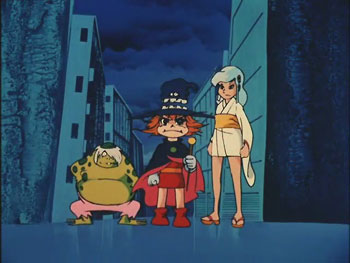
I have found several shows worthy of continued attention:
Hanasaku Iroha (Personal Growth ABC): The rural melodrama continues to charm, as the rather noisy Ohana tries her best to make her mark and get on with her teenage work-mates, who seem to have personality problems of their own.
Ano Hi Mita Hana no Namae o Bokutachi wa Mada Shiranai (We Still Don’t Know the Name of the Flower We Saw That Day): a.k.a. “Ano Hana.” The hero, encouraged by the ghostly Menma, contacts his former junior school buddies and tries to patch up their relationship. Seems his friends have problems of their own, related to Menma’s death. Â Continues to be an interesting drama.
Denpa Onna to Seishun Otoko (radio wave woman and laidback man): Bizarre moe comedy. The hero continues to try to sort out his weirdo and extremely cute-looking cousin while a couple of other girls take an interest in him. He also has to fend off his youthful-looking and very tactile auntie, who is nearly as flaky as her presumed child. Continues to be amusing, and interesting story-wise.
Kami Nomi 2 (The World God Only Knows 2): Gamer gets to grips with real girls. It’s still maintaining much of last year’s quality. In the latest episode, our hero is depressed by a particularly scornful real girl. However I just noticed that the school uniforms, scarlet last year, have become more brown.
Moshidora (Drucker in the Dugout): Full Japanese title is: Moshi KÅkÅ YakyÅ« no Joshi Manager ga Drucker no Management o Yondara (“What If the Female Manager of a High School Baseball Team Had Read Drucker’s ‘Management’?â€). It’s about a high school girl who is “manager†of the school baseball team, and who while looking for a baseball manager’s book, picks up Peter Drucker’s business management classic, and tries to use it to help her manage the team and aim for the Koshien. The ideas are interesting, the characters and the play less so.  In terms of characters and game play, it was much inferior to an Adachi Mitsuru baseball anime, but the ideas were interesting. Which is why I watched the whole thing, 10 eps.
Hyouge Mono: Cynical historical comedy. Still watching this excellent series. Only 3 eps subbed so far.
Showa Monogatari: Still watching this period drama. Interesting how different these characters are from the present generation. The 20 year old son has no idea how to dress for a date and clearly has little experience of girls, and the mature-looking daughter is trailed when she goes out on her own. Only 2 episodes subbed so far.
Steins; gate: Time travel SF. I’m still watching. However the principal character continues to be a pillock and there has been little real development of the theme, so I’m losing hope.
C – The Money of Soul and Possibility Control: Supernatural drama. I watched 2 eps and found it fairly good if a bit over-imaginative, so am not actively following it at present.
Dororon Enma-kun Meeramera: Rude horror comedy based on Go Nagai original. Not bad, but I’m not following it.
Ao no Exorcist (Blue Exorcist): Orphan in care of exorcism- performing religious order discovers that he can “see things†and that he possesses a strange power. Saw impressive 1st episode. I’m not actively following it.
Gothic: A 26-episode series, set in 1924. The cute Victorique and her Watson-like foil Kazuya continue to amuse.
Hen Zemi (Strange Seminar): Watched 2 episodes. Amusing and well-crafted smut. I’m not actively following this – guess I need to be in the right mood…
The rest: Dropped.
Spring 2011 anime- first looks
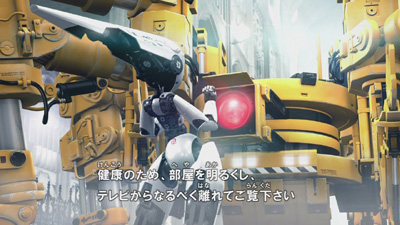
This post will be updated as new shows arrive.
Dog days: Junior high school gymnastics jock is whisked away to fantasy land where Dog People are battling Cat People in some kind of battle tournament. The Dog Republic is governed by a hereditary nobility :-(. Unoriginal, and not my kind of thing.
Hanasaku Iroha (Personal Growth ABC): 16 year old Ohana, abandoned by her feckless mother, goes to live with her grandmother, who runs a hot-spring hotel. The welcome isn’t as warm as she expected. This has a strong script, adequate art, and interesting characters. Promising. Ep. #2 excellent. [Streamed on Crunchyroll]
Nichijou (My Ordinary Life): Farcial gag comedy with schoolgirls. Amusing but frequently baffling; maybe it’s funnier in Japanese. Ep.#2 equally strange. [Streamed on Crunchyroll]
Steins; gate: Mysterious events occur around a time-travel theory seminar. A group of misfits meddle. A murdered woman. Intriguing time-travel sci-fi. [Streamed on Crunchyroll –not UK]
Oretachi wa Tsubasa wa nai (Without Wings – Under the Innocent Sky): Adapted from an ero-game. Lots of fanservice and sexy talk, multiple story threads. I didn’t care for the scene where an under-age girl shows her sexy undies and talks dirty. [Streamed on Crunchyroll]
Fireball Charming: 2-minute episode set on mecha planet. Great mecha animation, otherwise trivial.
Sengoku Otome – Momoiro Paradox (Battle Girls -Time Paradox): An average schoolgirl is transported to the Japanese Warring States period while praying for exam success at a shrine. However all the famous warlords, e.g. Oda Nobunaga, are women. One has a sinking feeling about this even before the opening credits are finished; it’s the usual magical rubbish with busty babes in skimpy armour. And why does Oda have only one attendant? The cute-but-dim heroine is the only good thing in it. Ep. #2: totally lame. [Streamed on Crunchyroll]
Tiger and Bunny: American-style superheroes work in a heavily sponsored reality TV show, where they get points for their success in catching villains. Hero “Tiger” isn’t doing well. Why watch? Don’t ask me. [Streamed on ANN, including UK]
Tono to Issho Gantai no Yabo: 3 minute episodes set in the Sengoku historical period. Slightly anachronistic and very funny. [Streamed on Crunchyroll]
SKET Dance: Transfer student encounters a strange club whose oddball members are dedicated to offering help and encouragement to other students. Ep #1 failed to arouse my enthusiasm. [Streamed on Crunchyroll]
Toriko: Shounen fantasy adventure about Toriko, who hunts down exotic ingredients for gourmet restaurants. Set on a fantasy world. (The first episode is a 50-minute Toriko x One Piece special. One Piece fans should enjoy it.) In Ep.#2, Toriko meets the timid chef Komatsu, hunts down the monstrous 8-legged Galala Crocodile, and eats it. If totally over the top manly fantasy adventure is your thing, you’ll like this.
Sekai Ichi Hatsukoi – World’s Greatest First Love: Funny and interesting story set in world of shoujo manga publishing. I liked it despite the few seconds of icky guy-guy kissing. Not for gay-haters, I think. #2nd episode lame, dropped. [Streamed on Crunchyroll]
A-Channel: Tiny Tooru is a bit too fond of her school friend, the dangerously scatty Ran, who since entering high school has acquired two female friends and several male acquaintances. Much comedy action ensues. I doubt if I’ll be watching much more of this, having taken a strong dislike to the near-psychotic Tooru.
Dororon Enma-kun Meeramera: Enma, nephew of the prince of Hell, and his associates, ice-wielding Princess Yukiko and the kappa Kappaeru, and Enma’s talking hat Chapeau, are sorting out the human world’s demons. Harumi, a schoolgirl, gets mixed up in their activities. All good fun, with slick modern designs, a little fan-service, and plenty of humour. {The original 1973 Go Nagai anime is pretty good too – though it looks its age it has more demon-battling action and less messing about in ep.#1}
30-sai no Hoken Taiiku (A Thirty-Year Old’s Health and Physical Education): Japan is said to have many 30 year-old virgins – this is a (censored) guide for them on how to date and have sex with women. Ep. #1 was so dire that watching 25 mins of it was like hard work. Don’t go there.
Happy Kappi: harmless stuff for kids.
Sofuteni: Soft tennis, played with a larger soft ball, is a popular game in Asia. This is another school comedy, with a group of cute girls doing cute things. It’s enlivened by fan-service, which includes some of the girls’ lurid imaginings. Not so bad, but not original enough to make it a must-see.
Hen Zemi (Strange Seminar): Nanako is a normal university student who happens to enroll in an Abnormal Physiology seminar. The lecturer and the other students are sexual deviants who persistently harass and embarrass Nanako. This show reveals the Japanese taste for body function humour. It’s ecchi, rude, abusive, and disgusting, but also rather smart and funny.
Showa Monogatari (Post-war Story): A story about daily life in the early 1960’s and supposedly aimed at older folks who remember those times. No fansub yet, which makes it hard to review, but it’s a reminder of what interested folks at that time.
Hyouge Mono: Historical drama. The story is set during Japan’s Warring States era and centers on Furuta Sasuke, a vassal of the great warlord Oda Nobunaga. He is obsessed with tea ceremony and material elegance, rather than with war. The art is interesting, and it’s clearly meant to be funny. I’ll continue to watch this. [There’s an online translated manga available. The anime follows the manga closely.]
Astarotte no Omocha (Astarotte’s Toy): Astarotte is a 10 year old succubus princess, and has to acquire a male harem, so that she can, er, suck their male essence. The animation style suggests that it’s for 10 year olds, and the first episode treads a fine line between moe cuteness and kiddy porn. However the late-night broadcast time implied that it’s really intended for adult pervs, not kids. Crunchyroll managed to “lose” my negative comment on this show! [Streamed on Crunchyroll].
Yondemasu yo, Azazel-san: About a private detective who has control of a demon used for dirty work. The demon, Azazel, is an unscary-looking sex fiend. The detective’s temporary worker, Sakuma is introduced to the demon. Contains some raunchy adult humour, and a bit repetitive, but at 12 minutes at least it’s short.
GyakkyÅ Burai Kaiji: Hakairoku-hen (Kaiji 2): sequel to harsh adult gambling comedy drama. Lowlife Kaiji, deep in debt to the Yakuza because of gambling, is kidnapped and put to work in a forced labour mine. Might not be everybody’s taste, but well-done.
Maria-holic Alive: Sequel to “Maria Holic”, in which lesbian Kanako was persecuted by her pretty boarding school room-mate who was really a boy in drag. In the first episode of the new series, Kanako is induced to undergo some fantastical trials in a supposedly disused wing of the school. Looks like the same stuff as before. Slickly done, but I’m not over keen on this comedy of bullying. [Licenced by Sentai – to be streamed in US & Canada]
Hoshizora e Kakaru Hashi (Bridge to the Stars): Kazuma’s younger brother has to move to the country for his health, and Kazuma accompanies him. Kazuma meets several girls, in variously embarrassing circumstances. A pretty if anodyne harem comedy, with mild fan-service. [Streamed on Crunchyroll]
The World God Only Knows 2: Like last year, the game master hero, aided by little demon Elsie is sending bad souls back to Hell by winning the hearts of real girls. No development from last year, but that could still mean it’s very good. [Streamed on Crunchyroll]
Ano Hi Mita Hana no Namae o Bokutachi wa Mada Shiranai (That day we saw a flower whose name we do not yet know): The hero is being bothered by a very annoying younger girl. Gradually we discover that nobody else can see her, and that he’s a recluse alienated from his former friends. There’s a situation he needs to fix. Tolerably well-scripted but gloomy scenario.
Hidan no Aria (a.k.a. Aria of the Scarlet Ammo): Harem comedy with guns, set around a high school for young bounty hunters. Average stuff.
C – The Money of Soul and Possibility Control: Japan has been bailed ouit from a financial crisis, but citizens are struggling to survive. A student is offered a large sum of money, simply on the condition that he pay it back. He is then introduced to the mysterious Financial District. Bizarre supernatural comedy-thriller. I’ll definitely be watching the next episode. Streamed on Funimation (not UK), ANN’s Anime on Demand (UK)
Denpa Onna to Seishun Otoko (radio wave woman and laidback man): High school boy goes to live with his single aunt, only to discover that he has a cousin who claims to be an alien and goes around wrapped in a futon. Totally bizarre. I’ll definitely be watching the next episode.
Deadman Wonderland: A 14 year old high school boy sees his class massacred by a red figure with supernatural powers. Subsequently he is accused of the crime, and despite his protests convicted on the evidence of a taped confession in which he boasts of the crime. He is sent to a private prison/theme park called “Deadman Wonderland”. A strange girl in a white bodysuit jumps down from the roof to talk to him. Around mid-episode the hero says “This can’t be happening..” which prompted this viewer to think “You’re right, it can’t”. I wasn’t impressed by this horror/conspiracy show.
Ao no Exorcist (Blue Exorcist): Orphan in care of exorcism- performing religious order discovers that he can “see things” and that he possesses a strange power. Fairly well-scripted and looks promising. Steamed on Crunchyroll (not UK).
Moshidora (Drucker in the Dugout): Full Japanese title is: Moshi KÅkÅ YakyÅ« no Joshi Manager ga Drucker no Management o Yondara (“What If the Female Manager of a High School Baseball Team Had Read Drucker’s ‘Management’?”). It’s about a high school girl who is “manager” of the school baseball team, and who while looking for a baseball manager’s book, picks up Peter Drucker’s business management classic, and tries to use it to help her manage the team and aim for the Koshien. The ideas are interesting, the characters and the play less so. Will watch some more episodes. [This show was originally scheduled for March, but is now being shown daily in April/May]
UK Anime release schedule courtesy of http://www.uk-anime.net.
Shonen Sarutobi Sasuke (Magic Boy) movie
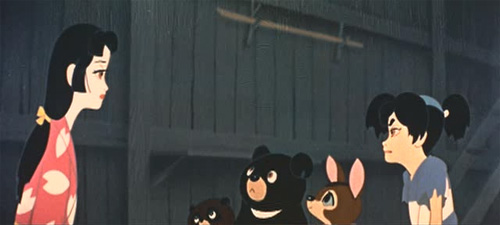 I recently tracked down a copy of the Magic Boy (Shonen Sarutobi Sasuke) movie [a.k.a. “The Little Samurai”] made in 1959. This is very early anime, and was the first Japanese anime to get a theatrical release in the USA. Even today, the quality of the animation is quite good, and it’s well worth a look. Bear in mind that in 1959, colour TV anime was still several years in the future!
I recently tracked down a copy of the Magic Boy (Shonen Sarutobi Sasuke) movie [a.k.a. “The Little Samurai”] made in 1959. This is very early anime, and was the first Japanese anime to get a theatrical release in the USA. Even today, the quality of the animation is quite good, and it’s well worth a look. Bear in mind that in 1959, colour TV anime was still several years in the future!
The story is set in an alternate mediaeval Japan. Young Sasuke plays with his animal friends, till an encounter with a witch, who kills one of the animals and attacks Sasuke. Â Sasuke goes off to learn to be a great magician, so that he can defeat the witch. Add some bandits and a local lord, and you have the story.
The movie came with three soundtracks (Jap, Eng, Spanish), and an Italian .srt file, but no English subs.  There’s a  Japanese-only DVD available if you feel like aiding Japan right now. In fact this isn’t a movie that depends heavily on dialogue, and there are passages several minutes long without any. One of the animals is killed in an incident rather reminiscent of the death of Bambi’s mother 🙂
After struggling with the .srt file, I made my own English subs .srt file, which you can find in the Manga Translations part of this site (at the bottom of the M.T. page). Â I recommend using it with VLC Media Player.
Winter 2011 Anime review

With two of the more interesting series taking a week’s break, Â and the season well under way, it seems a good time to look at what’s good and what’s not. Â Confounding one’s fears last year that decent anime was about to be history, a number of the latest series have great artwork, interesting characters, and well-crafted scripts with an ongoing storyline. In general they are far more sophisticated than say the anime of the 1960’s and 1970’s.
Mahou Shoujo Madoka Magica is the hit of the season. Many thought this was going to be just an updated magical-girl series, with added magical-trip effects, till in episode 3 the story takes a markedly darker turn. To underline this, #1 and #2 had action playing under the end credits, while #3 onwards have the pounding and distinctly doom-laden ending song. (Those given to re-running episodes will note that it’s previewed at a lower volume during the fight in #2.) Â Episode #3 reveals to general shock that being a magical girl can be fatal, and the nightmare continues in episodes #4-6 as further shocking events and revelations continue. Â These girls evidently get a huge ‘high’ from the exercise of their powers, and their motivation is not necessarily directed towards the common good. Â The cute-faced familiar, Kyubei , urges Madoka and her friend to contract as magical girls with an eagerness more usually met with in drug pushers. Â Al in all, a series that leaves the viewer in mild shock at the end of each episode isn’t updating the magical-girl genre so much as demolishing it.
Each episode has a hallucinogenic magical-combat sequence, and each one is totally different. Some think it’s worth watching for these alone.
Halfway through, the eponymous Madoka still hasn’t become a magical girl. Will she? and what will happen when she does? Â Is Kyubei evil? What ghastly thing will happen next? We want to know!
Yumekui Merry (Dream Eater Merry) : When the real world and the world of dreams intersect, strange things happen. Â Yumeji Fujiwara has always been sensitive to other people’s dreams, even before a strange girl falls on top of him. Merry Nightmare has come from the dream world, and she wants to go back there. Â Fujiwara has a nightmare of being in the dream world, Â chased by cats. Â The dream-world intrudes into Reality. Â Fujiwara, a kind-hearted youth, decides to help Merry. Â The dream demons want Yumeji’s body as a vessel to access Reality. Â Initially, Fujiwara and Merry seek out dream-demons and battle them as a means of finding an exit for her to the Dream World, but the perspective changes.
This series has a warmth to it derived from the characters’ feeling for each other, and the storyline has developing twists and clues that require the viewer to pay attention and remember what happened in past episodes. Â There is also some fine artwork in the dream scenes.
Kore wa Zombie desu ka? (Is this a Zombie?) : Daft and hilarious comedy about a schoolboy who is already a zombie as the series starts. Â Errm, there’s a Wiki on this series so I don’t have to explain what it’s about… By episode 5 he has a magically powered girl, a necromancer girl, and a vampire ninja girl living at his house, somewhat against his wishes. He does his best to hold his own.
This is very funny, and the girls all have quite distinct and unique personalities. It’s the inventiveness that makes it worth watching. Why does the rather jail-bait Haruna insist on making Ayumu delicious fried egg lunches – with no rice? Why does Yu wear armour and never speak? Will the ninja-girl’s ample bosom poke Ayumu in the eye?
Gothic (ゴシック): Set in an imaginary European country, in 1924. Token Japanese schoolboy meets a tiny, brilliant and bossy blonde girl who solves gothic mysteries.  Not amazing, but can be quite a gripping watch. The setup is an excuse to pose and solve some Sherlock-Holmes style mysteries, invariably solved with brilliant deductions by Veronique. After an awkward start,  Kazuya and Veronique come to care about each other.  The story arcs, involving a death ship and a thief and a missing heiress, are rather fun.
Fractale: sci-fi anime, containing obvious homages to Miyazaki movies and Nadia TV series. Much discussed, much anticipated, but proving somewhat of a disappointment. It fails to convince the viewer that its world is internally consistent, and none of the characters are really likeable or admirable.  Some people are continuing to watch just so they can chuck rocks at it.
Hourou Musuko (Wandering Son) : This was widely anticipated as the “quality†anime of the season – another adaptation of a Shimura Takako manga – the other being the delicate drama “Aoi Hanaâ€.  Not for everyone, perhaps, but HM has outstanding artwork, a solid script and tactful storytelling about gender identity, which affects several of the characters in different ways. Can be quite spellbinding in its quiet way.
Level E: Earth is infested with aliens, all here for their different reasons, and the humans are the only ones who don’t know. This is having some good fun with “the aliens are among us” storylines.
Kimi ni Todoke 2 (Reaching You 2) : Eagerly awaited by those who loved the first series of this shoujo romantic comedy. 2011 episode #0 was a recap. In ep #1, it’s chocolate-giving day, and Sawako can’t quite screw up courage to give lovingly-made chocolates to Kazehaya, who hangs about in increasing disappointment.  Give him the chocs already, girl! The characters have moved up one school year but their relationship hasn’t.  Nice, but no need to watch unless you liked the first series so much you want to watch another 12 or 13 episodes of the same.
The rest? Dragon Crisis isn’t bad, and I didn’t pursue the others.
The World God Only Knows
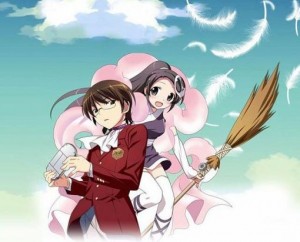 The World God Only Knows was one of the shows I passed over during the Autumn 2010 Japanese anime season, in favour of more enticing works. During a mild bout of ‘flu recently I watched the whole show and found it quite a bit better than I had anticipated. A show about a self-styled “God of Gaming” who doesn’t interact with real girls, and a demonic girl, doesn’t sound like a must-watch. Â In fact, there is a strong script, the characters are well rounded, and the girls are extremely cute (even cuter than the accompanying image suggests). There is no fan-service, which these days could be a plus point! The hero isn’t a hopeless loser – he just lacks social skills and loves gaming. When forced by the situation, Keima approaches real girls with determination, using the knowledge he has gained in gaming. The series pokes fun at the tropes of anime and games. For instance, when Keima comes home trailed by a little magical “half-sister” his mother welcomes Elsie – and promptly sues for a divorce.
The World God Only Knows was one of the shows I passed over during the Autumn 2010 Japanese anime season, in favour of more enticing works. During a mild bout of ‘flu recently I watched the whole show and found it quite a bit better than I had anticipated. A show about a self-styled “God of Gaming” who doesn’t interact with real girls, and a demonic girl, doesn’t sound like a must-watch. Â In fact, there is a strong script, the characters are well rounded, and the girls are extremely cute (even cuter than the accompanying image suggests). There is no fan-service, which these days could be a plus point! The hero isn’t a hopeless loser – he just lacks social skills and loves gaming. When forced by the situation, Keima approaches real girls with determination, using the knowledge he has gained in gaming. The series pokes fun at the tropes of anime and games. For instance, when Keima comes home trailed by a little magical “half-sister” his mother welcomes Elsie – and promptly sues for a divorce.
There’s also an extended  and well-scripted story arc involving a shy girl and incidentally promoting the joys of libraries and printed books.  This is a hot topic in the UK at the moment, where for generations we have had public libraries which are free to all, but are now under threat. Local authorities, having spent too much money on prestige building projects, fancy salaries for executives, and so forth, are now faced with a recession and are looking for a soft target for spending cuts.
Winter 2011 new anime licenses and streaming
Baffled by licensing of new season anime? Check here!
Beelzebub: Crunchyroll licence
Cardfight! Vanguard: Crunchyroll licence
Dragon Crisis: Crunchyroll licence
Fractale: Funimation streaming (not UK)
Gothic: Crunchyroll licence
Hourou Musuko: Crunchyroll licence
Infinite Stratos: Anime Network (USA) licence (not UK)
Kore wa Zombie desu ka?: Crunchyroll licence
Level E: Crunchyroll licence
Mitsudomoe 2: Crunchyroll licence
Rio – Rainbow Gate: Crunchyroll licence
Saint Seiya the lost canvas: Crunchyroll licence
Wolverine: G4TV streaming (not uk)
Yumekui Merry (Dream eater Merry) licensed by Sentai Filmworks – delivery method not disclosed.
All with Crunchyroll licence are streamed to US and UK unless otherwise indicated.
